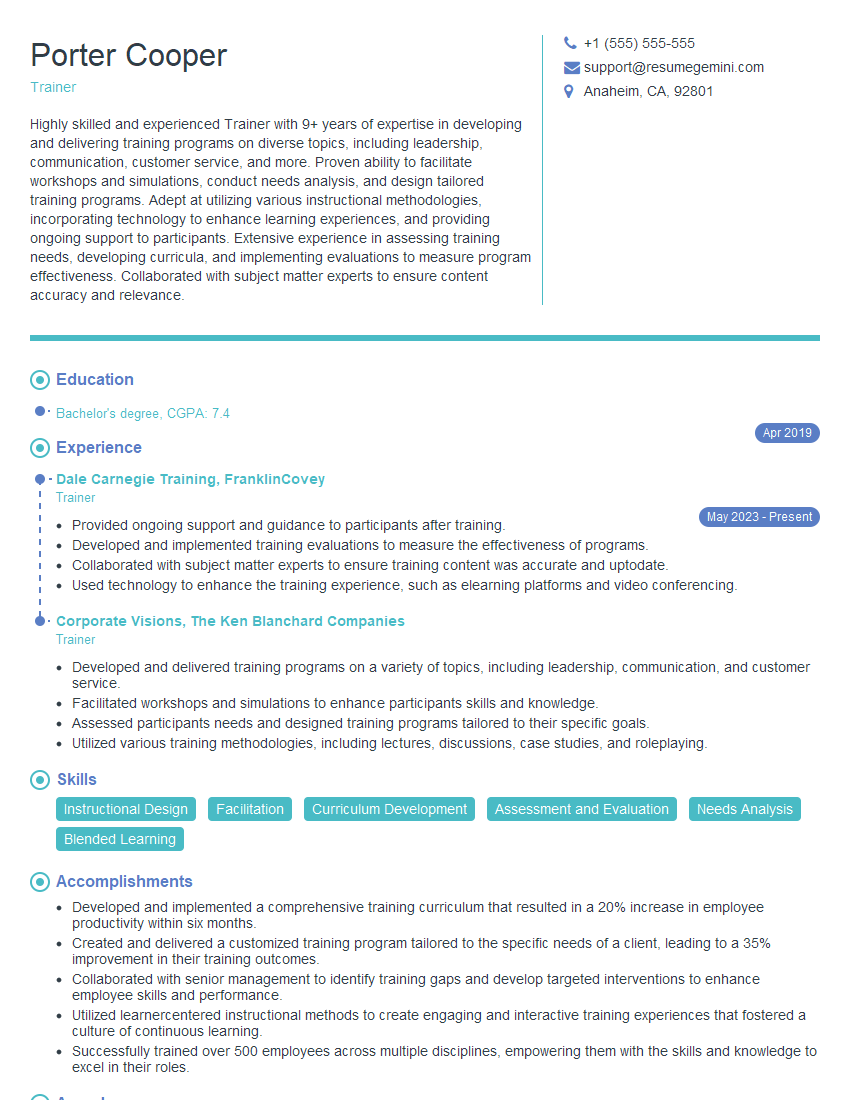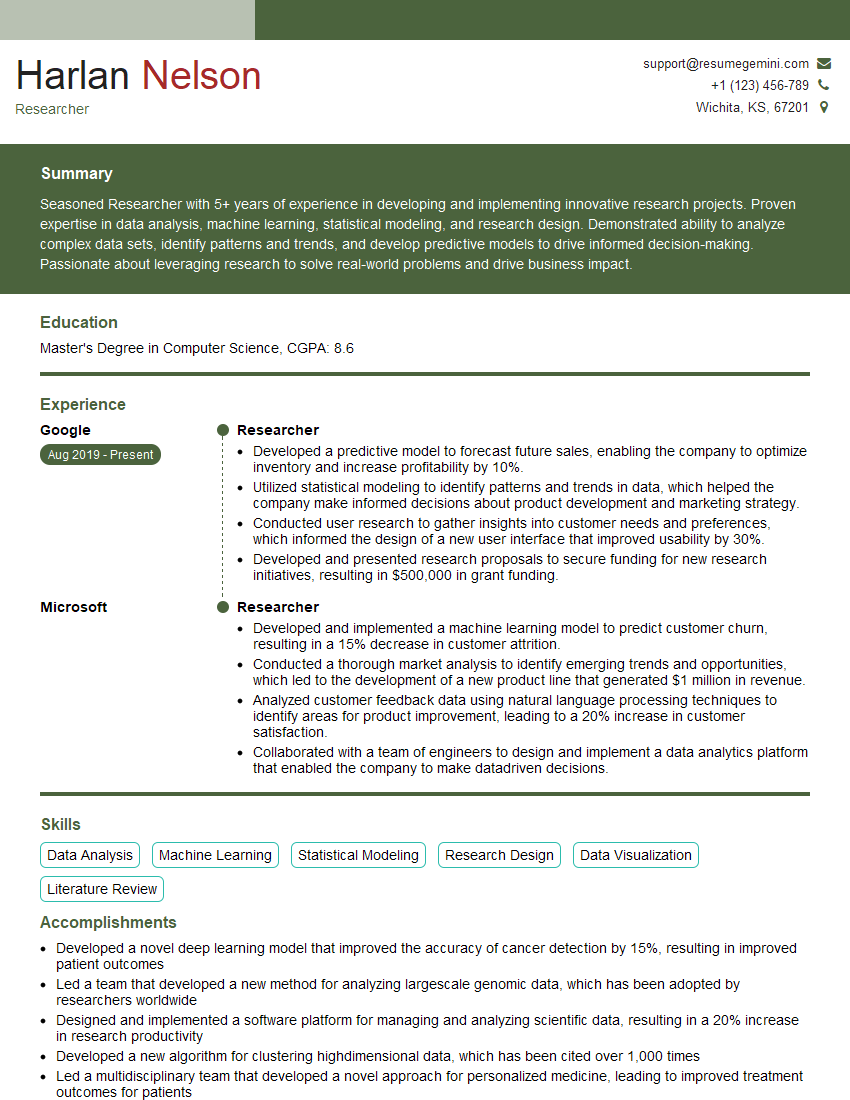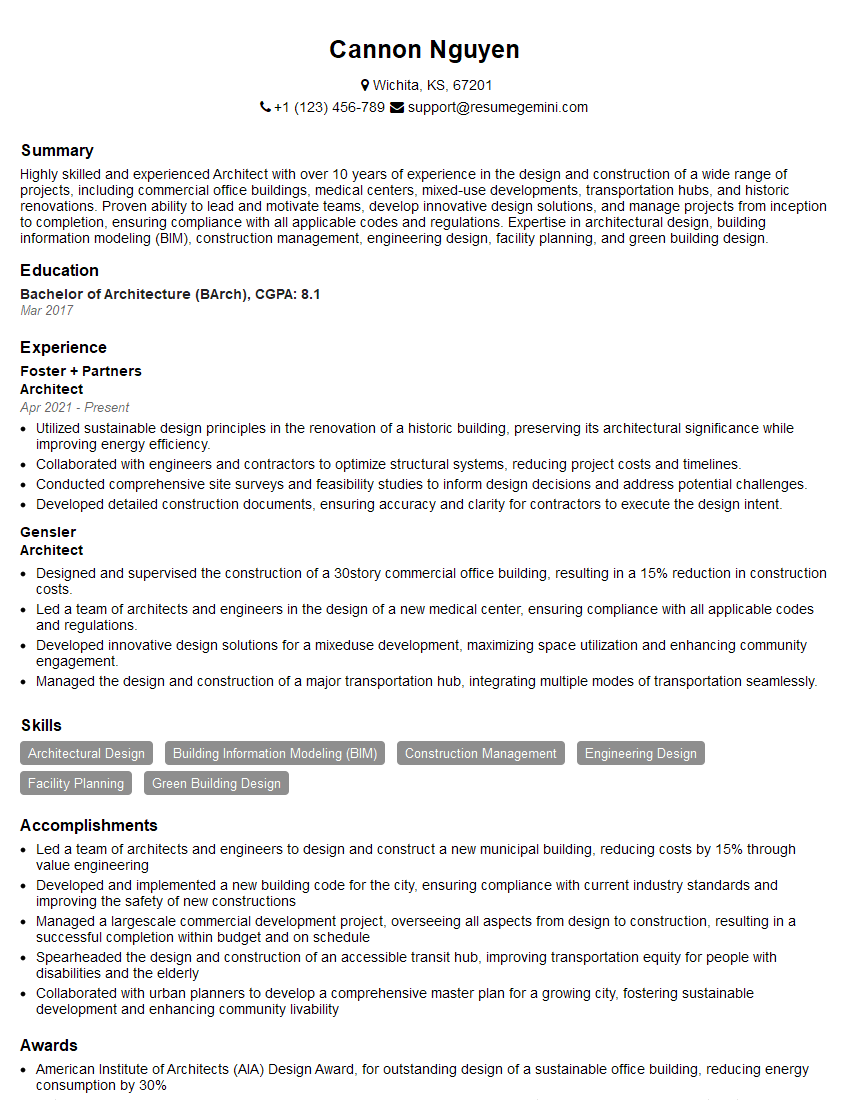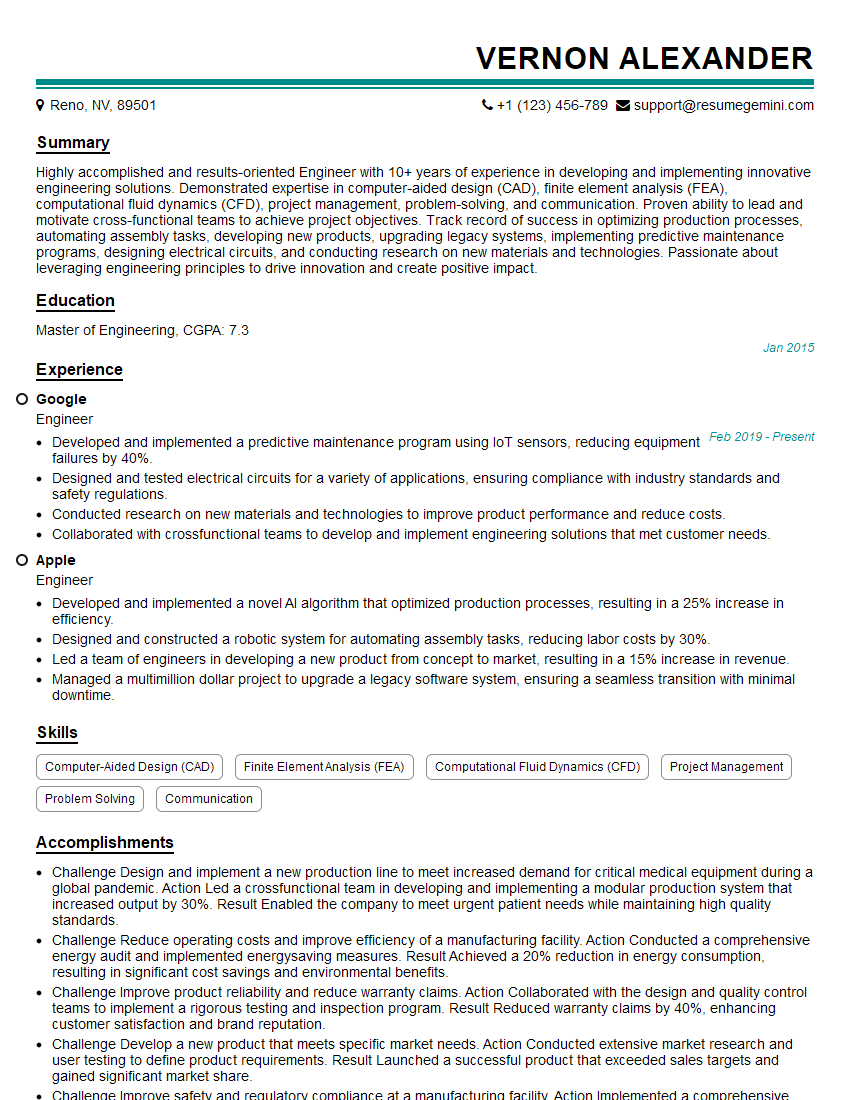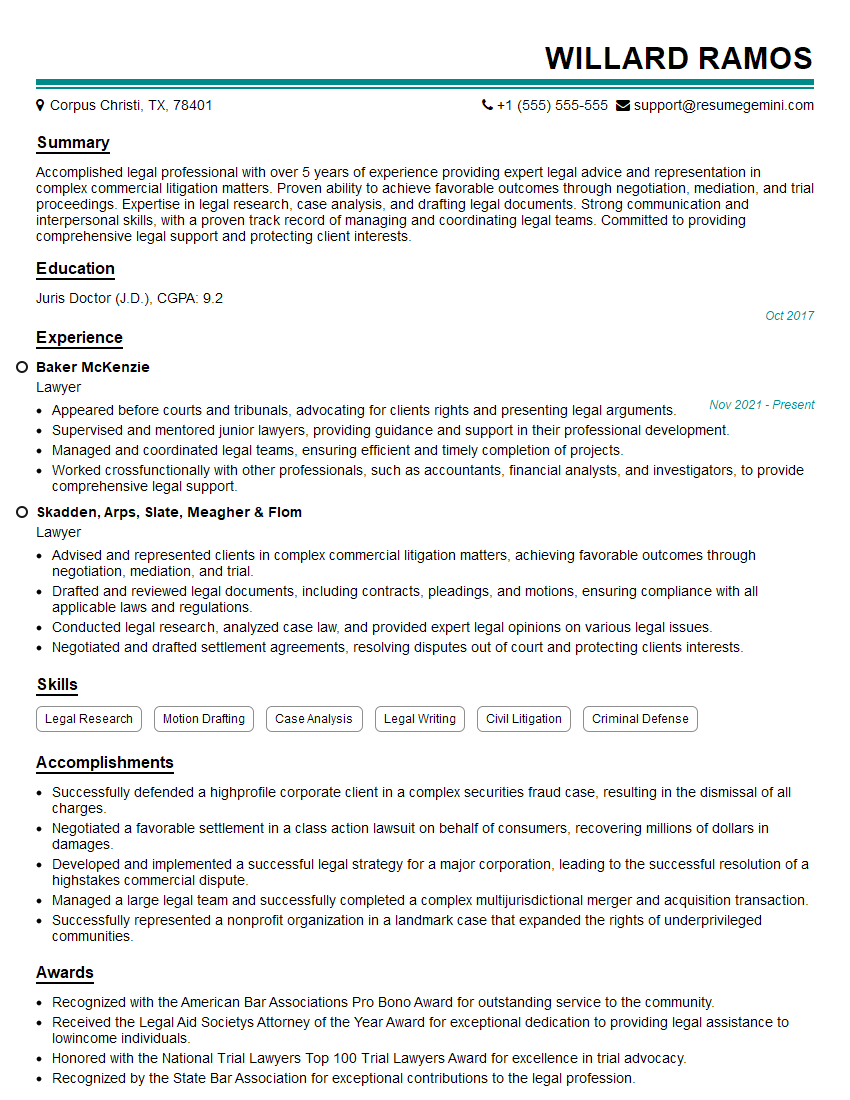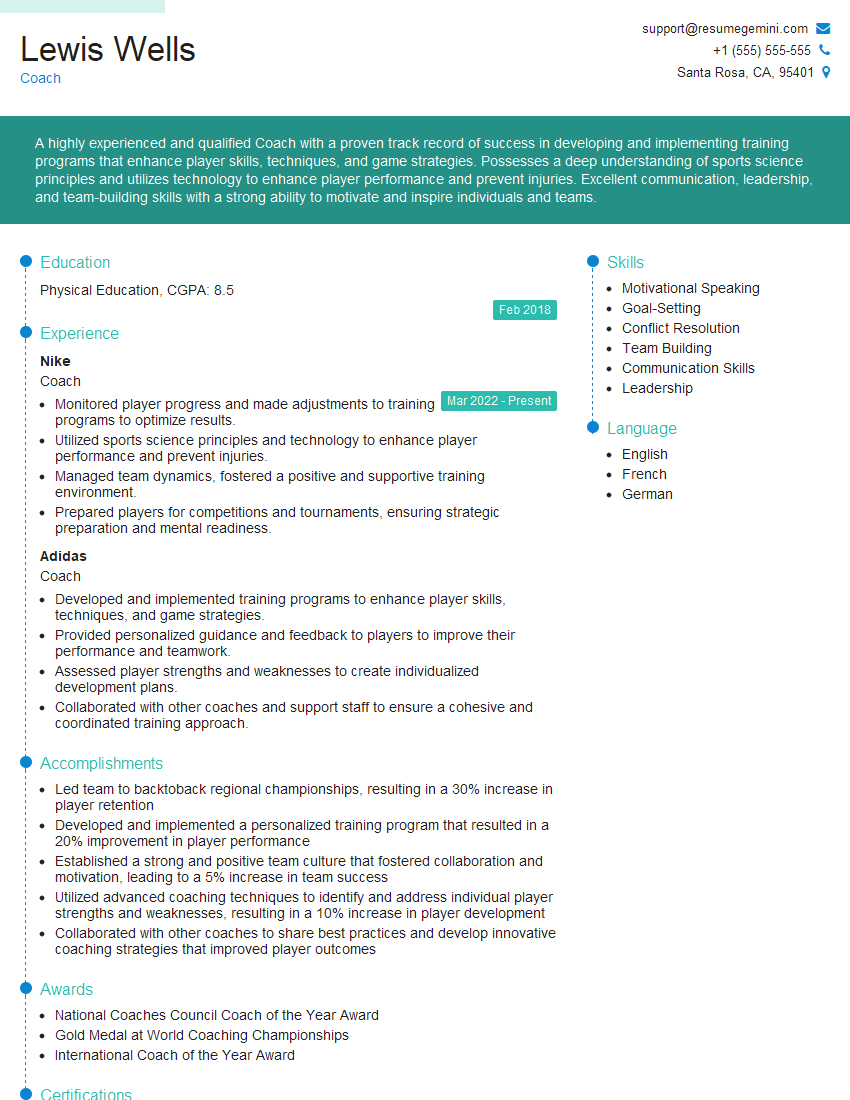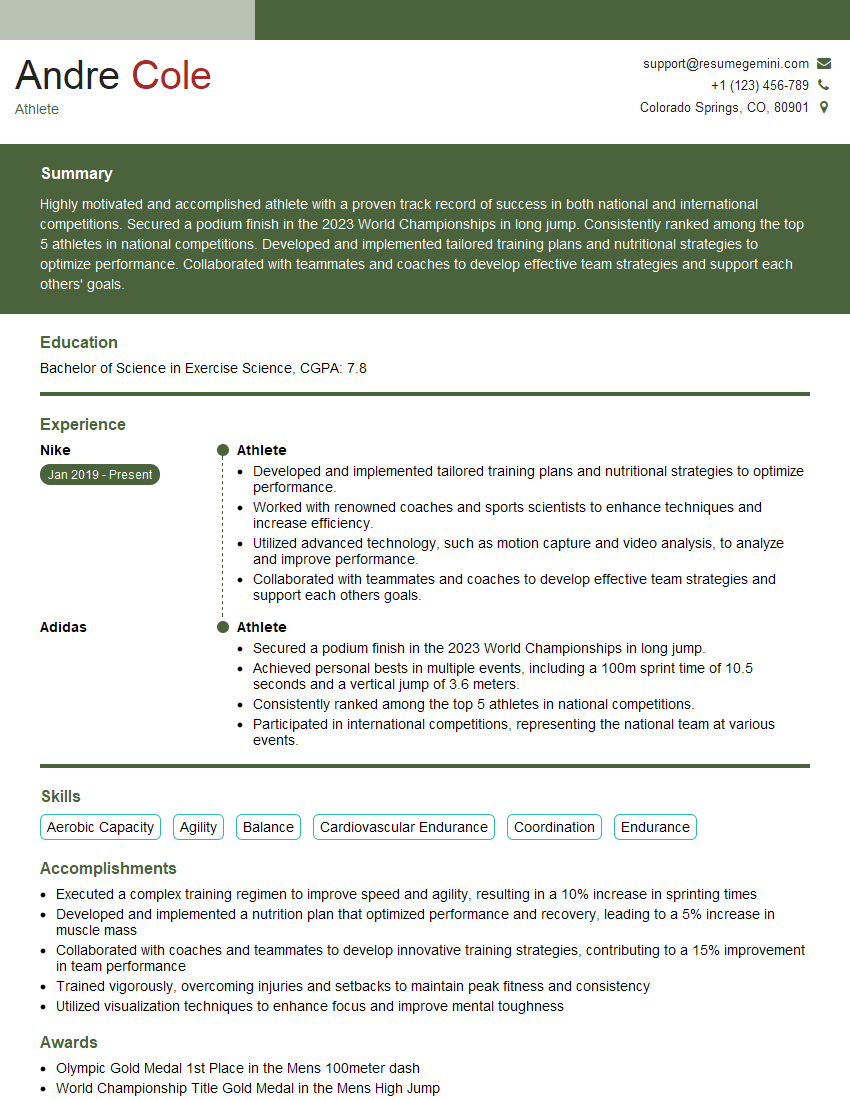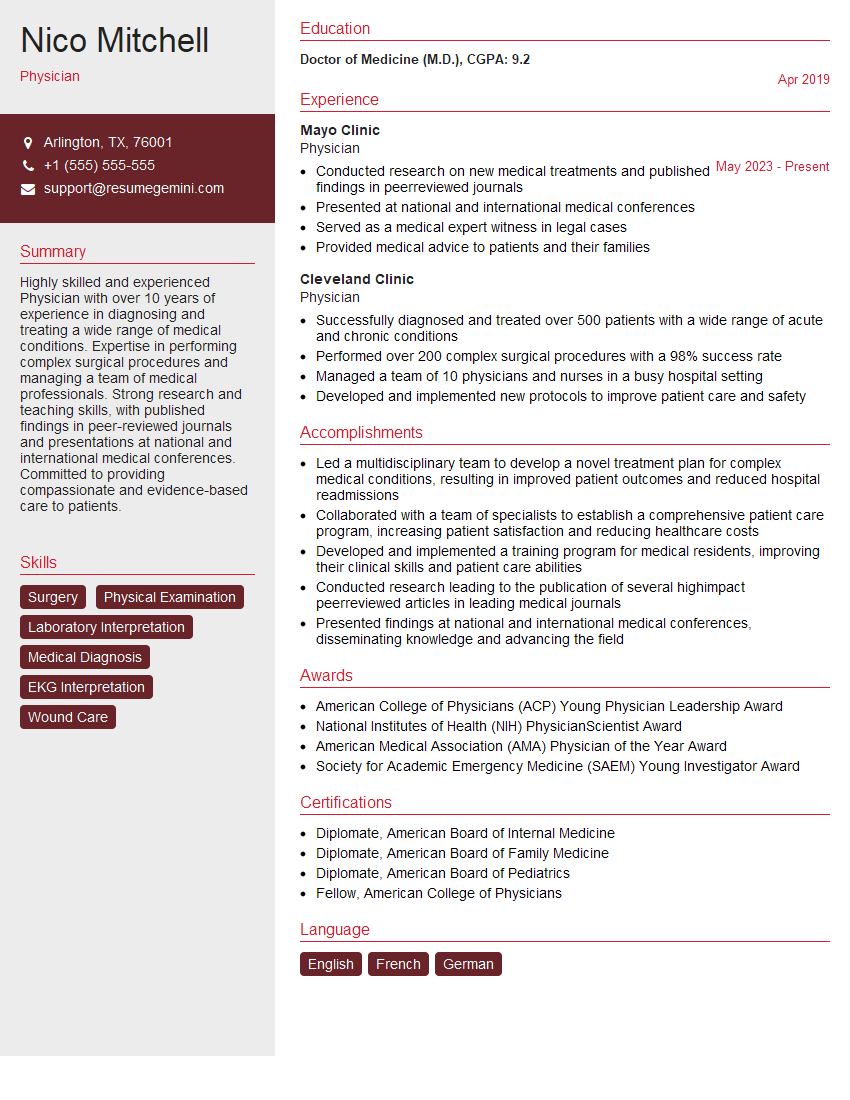Are you ready to stand out in your next interview? Understanding and preparing for Self-Motivation and Discipline interview questions is a game-changer. In this blog, we’ve compiled key questions and expert advice to help you showcase your skills with confidence and precision. Let’s get started on your journey to acing the interview.
Questions Asked in Self-Motivation and Discipline Interview
Q 1. Describe a time you overcame a significant obstacle requiring high self-discipline.
Self-discipline is the ability to control one’s feelings and overcome weaknesses; it’s the cornerstone of achieving ambitious goals. One significant obstacle I overcame was completing my doctoral dissertation. The sheer volume of research, writing, and revisions felt overwhelming at times. I countered this by breaking the project down into smaller, manageable tasks. Instead of focusing on the daunting ‘entire dissertation,’ I concentrated on completing one chapter at a time, with specific daily word counts. This approach prevented feelings of being overwhelmed and fostered a sense of accomplishment with each milestone reached. I also implemented a strict schedule, dedicating specific hours each day solely to writing, eliminating distractions like social media during these periods. This structured approach, coupled with consistent self-monitoring and regular feedback from my advisor, helped me maintain focus and stay on track, ultimately leading to successful completion.
Q 2. How do you prioritize tasks when facing competing deadlines?
Prioritizing tasks with competing deadlines requires a structured approach. I employ the Eisenhower Matrix (urgent/important), categorizing tasks based on their urgency and importance. Urgent and important tasks are tackled immediately. Important but not urgent tasks are scheduled. Urgent but not important tasks are delegated if possible, or efficiently dealt with to minimize disruption to higher-priority tasks. Finally, tasks that are neither urgent nor important are eliminated or postponed. This allows me to focus my energy and time on what truly matters, preventing last-minute rushes and ensuring timely completion of critical projects. For example, if I had a looming presentation deadline (urgent/important) and a less time-sensitive report (important/not urgent), I’d prioritize the presentation, allotting dedicated time slots for both, ensuring neither is neglected.
Q 3. Explain your approach to managing your time effectively.
Effective time management is crucial for productivity and well-being. My approach is multifaceted. Firstly, I utilize time-blocking, scheduling specific time slots for particular tasks. This prevents task-switching and improves focus. Secondly, I regularly review my to-do list, prioritizing tasks and adjusting my schedule as needed. I also incorporate buffer time between tasks to account for unforeseen delays or interruptions. Thirdly, I leverage technology; I use calendar apps and project management tools to track deadlines and progress. Finally, I emphasize regular breaks to avoid burnout. These short, deliberate breaks help maintain focus and prevent mental fatigue. Taking short walks or engaging in brief mindfulness exercises during these breaks significantly boosts my overall productivity and concentration.
Q 4. Describe a situation where you had to motivate yourself to complete a challenging task.
Motivation can wane, especially with challenging tasks. I once had to motivate myself to learn a new programming language for a critical project. The sheer volume of new concepts felt daunting. To overcome this, I broke the learning process into smaller, manageable modules, setting achievable daily goals. I rewarded myself after completing each module – a small treat, extra time for a hobby – reinforcing positive behavior. Visualizing the long-term benefits—the successful completion of the project and the enhanced skillset—also fueled my determination. Connecting the task to a larger, meaningful purpose significantly increased my intrinsic motivation, transforming a daunting challenge into a rewarding learning experience.
Q 5. How do you stay focused and avoid distractions when working on a complex project?
Maintaining focus on complex projects requires a proactive approach to minimizing distractions. I establish a dedicated workspace free from interruptions. This could be a quiet office or even a specific area in my home. I utilize website blockers to prevent access to distracting websites during work hours. I communicate my need for focused time to colleagues and family to minimize interruptions. Moreover, I employ the Pomodoro Technique, working in focused 25-minute intervals followed by short breaks. This structured approach helps maintain concentration and prevents burnout. Regular breaks, away from the screen, are vital for refreshing my mind and preventing mental fatigue, allowing me to return to the task with renewed focus and energy.
Q 6. What strategies do you use to maintain your motivation over long periods?
Sustaining motivation over extended periods demands consistent effort and strategic planning. I set SMART goals (Specific, Measurable, Achievable, Relevant, Time-bound) to ensure clarity and progress tracking. Regularly reviewing and celebrating milestones keeps me engaged and motivated. I also build in opportunities for learning and growth; exploring new techniques or acquiring additional skills within the project enhances intrinsic motivation. Finally, connecting with others working on similar tasks or seeking mentorship provides valuable support and maintains enthusiasm, preventing stagnation and fostering a sense of community and shared purpose.
Q 7. How do you handle setbacks and maintain your motivation after failure?
Setbacks and failures are inevitable. My approach involves viewing them as learning opportunities, not as personal defeats. I conduct a thorough post-mortem analysis of the failure, identifying contributing factors and areas for improvement. This analytical process transforms negative experiences into valuable lessons. I then adjust my strategies based on these insights, revising my plans and moving forward with renewed focus. Self-compassion is crucial; I acknowledge the difficulty of the situation and allow myself time to process emotions before refocusing on the task at hand. Maintaining a positive outlook and focusing on progress, rather than dwelling on setbacks, is essential for maintaining motivation and resilience.
Q 8. Describe your preferred method for setting and achieving goals.
My approach to goal setting and achievement is rooted in the SMART framework: Specific, Measurable, Achievable, Relevant, and Time-bound. Instead of vague aspirations, I break down large goals into smaller, manageable steps. For example, if my goal is to write a book, I wouldn’t just aim to ‘write a book,’ but instead, ‘write 500 words per day for the next six months.’ This specificity makes progress tangible and less daunting.
I utilize a combination of task management tools and a physical planner to track my progress. I visually represent the steps using a Kanban board or a simple checklist, which helps me stay organized and focused. The key is to make the process enjoyable and avoid feeling overwhelmed.
- Specificity: Clearly define your goal, leaving no room for ambiguity.
- Measurability: Establish concrete metrics to track progress (e.g., word count, sales figures, number of workouts).
- Achievability: Set realistic goals; break down large tasks into smaller, attainable ones.
- Relevance: Ensure the goal aligns with your overall objectives and values.
- Time-bound: Set deadlines to create urgency and maintain momentum.
Q 9. How do you measure your progress towards achieving a goal?
Measuring progress is crucial for maintaining motivation. I use a multi-faceted approach. Firstly, I establish key performance indicators (KPIs) related to my goals. These could be quantitative (e.g., number of sales, weight loss) or qualitative (e.g., client satisfaction, skill development). I track these KPIs regularly, using spreadsheets, project management software, or even a simple journal. Regular reviews (weekly or monthly) allow me to identify areas where I’m excelling and areas that need improvement, enabling course correction if necessary.
Beyond quantitative measures, I also reflect on my learning and development. Did I acquire new skills? Did I overcome challenges effectively? These qualitative assessments provide a more holistic view of my progress and boost my self-confidence.
For instance, if my goal is to improve my public speaking skills, I’d track the number of presentations I give, gather feedback from the audience, and reflect on my performance to identify areas for improvement. The combination of quantitative and qualitative data provides a comprehensive picture of my progress.
Q 10. What steps do you take to improve your self-discipline?
Improving self-discipline is an ongoing process that involves cultivating mindful habits and strengthening mental fortitude. I employ several strategies:
- Mindfulness and Self-Awareness: Regular mindfulness practices, such as meditation, help me become more aware of my impulses and tendencies. This allows me to identify triggers for procrastination or self-sabotage and develop coping mechanisms.
- Habit Stacking: I incorporate new habits into existing routines. For example, I might add 10 minutes of exercise to my morning routine instead of trying to start a whole new exercise regime.
- Accountability: Sharing my goals with a trusted friend or mentor can increase my accountability and motivation.
- Reward System: I reward myself for achieving milestones, making the process more enjoyable and reinforcing positive behaviour. It’s important to choose healthy and sustainable rewards.
- Consistent Sleep and Healthy Diet: These are fundamental to maintaining energy levels and mental clarity, crucial for self-discipline.
Q 11. How do you handle procrastination?
Procrastination is often rooted in fear, perfectionism, or a lack of clarity. My approach is to address these underlying issues. I begin by breaking down overwhelming tasks into smaller, less daunting steps. This makes the task seem less intimidating and easier to start. The ‘two-minute rule’ is also very effective – if a task takes less than two minutes, I do it immediately.
I also utilize the Pomodoro Technique: working in focused bursts (e.g., 25 minutes) followed by short breaks. This helps maintain concentration and prevents burnout. If the procrastination stems from fear or self-doubt, I address these feelings through self-compassion and positive self-talk.
Finally, I eliminate distractions. This might involve turning off notifications, finding a quiet workspace, or using website blockers to limit access to time-wasting websites. The goal is to create a supportive environment conducive to focused work.
Q 12. How do you maintain a positive attitude and motivation in a high-pressure environment?
Maintaining a positive attitude and motivation in high-pressure environments requires a proactive approach. I focus on cultivating resilience by developing coping mechanisms for stress. This includes regular exercise, mindful breathing techniques, and sufficient sleep. Regular breaks and prioritizing self-care are essential to prevent burnout.
I also actively seek opportunities for growth and learning, even within stressful situations. Viewing challenges as opportunities for development shifts my perspective from negativity to optimism. Remembering my ‘why’ – my purpose and long-term goals – also provides a powerful source of motivation when facing adversity.
Building strong relationships with colleagues also helps. Sharing challenges and successes with a supportive network provides a sense of community and strengthens resilience.
Q 13. Describe a time you had to work independently on a project. How did you stay motivated?
During my master’s thesis, I worked independently for several months. The key to staying motivated was breaking down the project into smaller, manageable tasks. I created a detailed timeline with specific deadlines for each chapter, outlining specific objectives for each week. I also utilized a visual progress tracker to see my overall advancement, which was extremely motivating.
Regular self-reflection was crucial. I scheduled time for review and evaluation, assessing my progress and adapting my plan as needed. This self-accountability kept me focused and prevented feelings of being overwhelmed. Celebrating small victories along the way – finishing a chapter, completing a significant analysis – helped maintain momentum. It was a marathon, not a sprint, and acknowledging these small successes fueled my motivation throughout the long process.
Q 14. How do you handle criticism and use it to improve your performance?
I view criticism as an opportunity for growth and improvement. My approach involves actively listening to feedback without getting defensive. I try to understand the perspective of the person offering the criticism and seek clarification if needed. I separate the message from the messenger, focusing on the constructive elements of the feedback.
After receiving feedback, I reflect on it thoughtfully. I identify areas where I can improve my skills or approach. I then create a plan to address the feedback, setting specific goals and timelines for improvement. This process is iterative; I track my progress and continually refine my approach based on ongoing feedback and self-assessment.
For example, if I receive criticism about a presentation being too technical, I’d plan to simplify my language, use more visuals, and incorporate audience interaction to make it more engaging. This constructive process allows me to leverage criticism to enhance my performance and become a more effective professional.
Q 15. Describe a time you had to adapt to a sudden change in priorities. How did you manage your time and energy?
Adapting to sudden changes requires a flexible mindset and a structured approach to time management. Imagine this: I was deeply immersed in a long-term research project on the neurobiology of motivation when a critical client needed immediate support. My initial reaction was a surge of stress, but I quickly shifted gears.
Prioritization: I used the Eisenhower Matrix (urgent/important) to categorize my tasks. The client’s urgent need took precedence, while less critical aspects of the research were temporarily deprioritized.
Time Blocking: I allocated specific time slots for the client project, ensuring focused work without letting it bleed into my research time. This prevents burnout and maintains a sense of control.
Energy Management: I recognized the importance of taking short breaks for mindful activities – brief walks or meditation – to refresh my mental energy. This prevents decision fatigue and enhances my efficiency during focused work.
Communication: I proactively communicated the shift in my priorities to my research team, ensuring they understood the temporary change in my availability and my commitment to eventually resuming our work.
This situation highlighted the importance of both proactive planning and adaptable strategies. By strategically managing my time and energy, I successfully navigated the unexpected shift and ensured both projects progressed without compromising quality.
Career Expert Tips:
- Ace those interviews! Prepare effectively by reviewing the Top 50 Most Common Interview Questions on ResumeGemini.
- Navigate your job search with confidence! Explore a wide range of Career Tips on ResumeGemini. Learn about common challenges and recommendations to overcome them.
- Craft the perfect resume! Master the Art of Resume Writing with ResumeGemini’s guide. Showcase your unique qualifications and achievements effectively.
- Don’t miss out on holiday savings! Build your dream resume with ResumeGemini’s ATS optimized templates.
Q 16. What are your strategies for staying organized and managing multiple tasks simultaneously?
Staying organized and managing multiple tasks effectively requires a blend of strategic planning and practical tools. I utilize a combination of techniques, including:
Task Management Systems: I employ project management software (like Asana or Trello) to visually organize my tasks, set deadlines, and track progress. This allows for a clear overview of all commitments and facilitates prioritization.
Time Blocking: Scheduling specific times for specific tasks prevents multitasking and improves focus. I group similar tasks together (e.g., all email responses in one block) to leverage momentum and minimize context switching.
Prioritization Matrices: I regularly use the Eisenhower Matrix (urgent/important) and MoSCoW method (Must have, Should have, Could have, Won’t have) to determine which tasks require immediate attention and which can be delegated or postponed.
Regular Review and Adjustment: I review my schedule and task lists daily, adjusting priorities as needed based on changing circumstances. Flexibility is key – plans need to evolve as new information emerges.
Imagine trying to juggle several balls – without a system, chaos ensues. But with a structured approach and the right tools, juggling multiple tasks becomes manageable and even efficient. The key is to find what works best for you and consistently apply the strategies.
Q 17. How do you identify and address your personal weaknesses that hinder self-discipline?
Identifying and addressing personal weaknesses that impede self-discipline is an ongoing process of self-reflection and improvement. My approach involves:
Self-Awareness: I regularly assess my behavior and identify patterns that hinder self-discipline. For example, I might notice a tendency to procrastinate on challenging tasks. Honest self-assessment is the first step.
Journaling: I maintain a journal to track my progress, note setbacks, and analyze their root causes. This helps pinpoint recurring patterns and identify triggers that lead to self-sabotaging behaviors.
Seeking Feedback: I actively seek feedback from trusted colleagues, friends, and mentors to gain external perspectives on my strengths and weaknesses. Often, others notice patterns we might miss ourselves.
Developing Compensatory Strategies: Once a weakness is identified, I develop specific strategies to address it. If procrastination is a problem, I might implement techniques like the Pomodoro Technique or time blocking to create structure and overcome inertia.
Mindfulness and Self-Compassion: Recognizing that setbacks are part of the process and practicing self-compassion is essential. Self-criticism is counterproductive; focusing on progress rather than perfection fosters a more sustainable approach.
Addressing personal weaknesses isn’t about achieving perfection; it’s about continuous growth and improvement. It’s a journey, not a destination.
Q 18. What resources or techniques do you utilize to enhance your focus and concentration?
Enhancing focus and concentration requires a multi-pronged approach that addresses both internal and external factors. I utilize a combination of:
Mindfulness and Meditation: Regular mindfulness practices help train the mind to focus and resist distractions. Even short meditation sessions can significantly enhance attention span.
Optimized Workspace: Creating a dedicated workspace free from distractions is crucial. This includes minimizing clutter, turning off notifications, and using noise-canceling headphones if needed.
Time Management Techniques: The Pomodoro Technique (working in focused bursts with short breaks) and time blocking help structure my work and prevent mental fatigue.
Regular Breaks: Short breaks throughout the day are essential to prevent mental burnout. These breaks should involve activities that promote relaxation and rejuvenation, like short walks or stretching.
Prioritization and Task Chunking: Breaking down large tasks into smaller, more manageable chunks makes them less daunting and improves focus. Prioritizing ensures I focus my energy on the most important tasks first.
Focus is like a muscle; the more you train it, the stronger it becomes. Consistent application of these techniques strengthens mental focus and enhances productivity.
Q 19. How do you balance work and personal life to maintain both productivity and well-being?
Balancing work and personal life is crucial for both productivity and well-being. It’s not about rigid separation, but rather about intentional integration. My approach involves:
Setting Boundaries: Establishing clear boundaries between work and personal time is essential. This might include setting specific work hours, disconnecting after work hours, and designating specific locations for work and relaxation.
Prioritization and Delegation: Prioritizing tasks and delegating where possible frees up time for personal activities. Learning to say ‘no’ to non-essential commitments is crucial.
Scheduling Personal Time: Just as I schedule work tasks, I schedule time for personal activities, hobbies, and social connections. Treating these appointments with the same seriousness as work commitments ensures they happen.
Mindfulness and Self-Care: Prioritizing self-care activities – exercise, healthy eating, sufficient sleep – is essential for maintaining both physical and mental well-being, which directly impacts productivity.
Regular Evaluation: Periodically evaluating the balance between work and personal life allows for adjustments as needed. What works well one week might need modification the next.
Think of work and personal life as two sides of a coin; neglecting one inevitably impacts the other. A balanced approach ensures both sides remain strong and contribute to overall well-being.
Q 20. Describe your approach to seeking feedback and using it to improve your self-motivation.
Seeking and utilizing feedback is vital for improving self-motivation. My approach involves:
Proactive Solicitation: I regularly solicit feedback from colleagues, supervisors, and mentors, focusing on both my strengths and areas for improvement. I specifically ask for feedback on my progress towards goals and strategies for enhancing my motivation.
Openness to Criticism: I embrace constructive criticism, viewing it not as a personal attack, but as valuable information for self-improvement. A critical perspective can illuminate blind spots and guide adjustments.
Specific Questions: I ask specific questions to guide the feedback process, such as: “What are some areas where I could improve my approach?” or “How can I stay more focused on my long-term goals?” This ensures relevant and actionable feedback.
Reflection and Action: After receiving feedback, I take time to reflect on it, identifying actionable steps to incorporate the suggestions. Simply receiving feedback is insufficient; the key is to integrate it into my practices.
Appreciation: I express gratitude for the feedback, acknowledging the value of the person’s time and insights. This strengthens the relationship and encourages future feedback.
Feedback acts as a navigational tool, guiding me toward more effective self-motivation strategies. It is a continuous learning process.
Q 21. How do you stay motivated when working on repetitive tasks?
Maintaining motivation during repetitive tasks requires a strategic approach. Simple repetition can lead to boredom and decreased productivity. My strategies include:
Chunking and Goal Setting: Breaking large, repetitive tasks into smaller, manageable chunks with specific goals for each chunk makes the overall task seem less overwhelming.
Gamification: Introducing elements of gamification, such as setting mini-challenges, tracking progress, or rewarding myself for completing certain milestones, can make repetitive tasks more engaging.
Varied Activities: If possible, I try to vary the tasks or the order in which they are performed to prevent monotony. This can increase engagement and provide mental breaks.
Mindfulness and Breaks: Practicing mindfulness during repetitive tasks helps maintain focus and awareness. Taking regular short breaks helps to avoid mental fatigue and maintain motivation.
Focusing on the Bigger Picture: Remembering the overall purpose and significance of the repetitive task helps maintain long-term motivation. Connecting the task to a larger goal provides context and meaning.
Repetitive tasks don’t have to be monotonous. With a creative approach, these tasks can be approached with renewed energy and focus.
Q 22. How do you delegate tasks effectively when working with a team?
Effective delegation isn’t just about assigning tasks; it’s about empowering your team. It begins with understanding each team member’s strengths, weaknesses, and current workload. I assess the task’s complexity, required skills, and deadlines before assigning it. For example, a complex project might require breaking it down into smaller, manageable sub-tasks, delegating each to the most suitable person. I always ensure clear communication of expectations, providing necessary resources and support, and establishing clear deadlines and reporting mechanisms. Regular check-ins and feedback sessions are crucial to ensure progress and address any roadblocks. Finally, I recognize and appreciate contributions to foster a positive and collaborative environment.
- Understanding Team Capabilities: A SWOT analysis (Strengths, Weaknesses, Opportunities, Threats) of each team member can inform task allocation.
- Clear Communication: Using project management tools and holding regular meetings ensure everyone is on the same page.
- Empowerment and Trust: Allowing team members autonomy within defined parameters fosters ownership and responsibility.
Q 23. Describe a time you had to motivate a team member who was struggling.
I once worked with a team member who was struggling with a particularly challenging coding task. Initially, I noticed a drop in their usual enthusiasm and productivity. Instead of directly criticizing their work, I started by scheduling a one-on-one meeting to understand the root cause of their struggle. It turned out they were overwhelmed by the complexity of the codebase and felt lacking in certain technical skills. To address this, I provided targeted support, offering mentorship, pairing them with a more experienced colleague for collaborative problem-solving, and identifying relevant online resources and training materials. I also adjusted their workload to ensure they weren’t overwhelmed. Through consistent encouragement, we broke down the task into smaller, manageable chunks, celebrating each milestone achieved. This supportive approach helped restore their confidence and ultimately led to successful project completion.
Q 24. How do you measure your own success and define accomplishment?
My success isn’t measured solely by tangible achievements, but also by my personal growth and impact. I define accomplishment in terms of three key areas:
- Goal Achievement: Did I successfully complete the tasks and projects I set out to achieve? This includes meeting deadlines and exceeding expectations where possible.
- Skill Development: Did I acquire new skills, improve existing ones, or push myself beyond my comfort zone? Continuous learning is essential for professional growth.
- Positive Impact: Did my work contribute to the success of my team, organization, or clients? Making a meaningful difference is a vital measure of success for me.
I regularly review my progress using a combination of self-reflection and feedback from colleagues and supervisors. This allows for honest self-assessment and identification of areas for improvement.
Q 25. What are your long-term career goals, and how do you plan to achieve them?
My long-term career goal is to become a recognized thought leader in the field of self-motivation and discipline within organizational settings. I aim to develop and deliver impactful training programs and consulting services that help individuals and teams unlock their full potential. To achieve this, I plan to:
- Enhance my expertise: Pursue advanced certifications and engage in continuous learning to stay abreast of the latest research and best practices.
- Build my network: Actively participate in industry conferences, workshops, and online communities to connect with fellow professionals and expand my reach.
- Develop my communication skills: Enhance my ability to present complex information in a clear, engaging, and relatable manner through practice and feedback.
- Create valuable content: Develop and share thought leadership content such as articles, blog posts, and presentations to establish myself as an expert in the field.
Q 26. How do you learn from your mistakes and avoid repeating them?
I believe mistakes are valuable learning opportunities. My approach to learning from mistakes is systematic:
- Identify the mistake: Clearly define what went wrong, avoiding blame and focusing on the factual aspects.
- Analyze the cause: Explore the underlying reasons that led to the mistake. Was it a lack of knowledge, poor planning, inadequate resources, or something else?
- Develop solutions: Brainstorm and implement strategies to prevent the same mistake from happening again. This might involve improved processes, new skills, or adjustments to my work style.
- Document the learning: Keep a record of my mistakes and the lessons learned. This serves as a valuable reference for future decision-making.
- Seek feedback: Discuss the mistake with trusted colleagues or mentors to get diverse perspectives and identify blind spots.
This process helps me transform errors into valuable experiences that enhance my skills and judgment.
Q 27. Describe a time you had to work under pressure to meet a tight deadline. How did you maintain your focus?
I once had to deliver a critical presentation under extremely tight deadlines. To maintain focus, I employed several strategies:
- Prioritization: I focused on the most crucial aspects of the presentation, leaving out less essential details to meet the deadline.
- Time Management: I created a detailed schedule, allocating specific time slots for research, writing, design, and rehearsal.
- Mindfulness Techniques: I practiced mindfulness and meditation to stay calm and centered under pressure.
- Breaks and Rest: I ensured I took short breaks to prevent burnout and maintain energy levels. These were strategic breaks to clear my head, not just distractions.
- Collaboration: I leveraged my team’s strengths, delegating some tasks to lighten my workload.
The result was a successful presentation delivered on time, showcasing resilience and effective time management.
Q 28. How do you ensure that your personal values align with your professional goals and actions?
Alignment between personal values and professional goals is crucial for long-term fulfillment and success. I actively ensure this alignment by:
- Self-Reflection: Regularly reflecting on my values—integrity, dedication, continuous learning, and collaboration—helps me understand what truly motivates me.
- Goal Setting: I set professional goals that are congruent with my values. For instance, my commitment to continuous learning is reflected in my pursuit of advanced certifications and my desire to contribute to the field.
- Ethical Decision-Making: I consistently make professional decisions that reflect my values. Even under pressure, I prioritize integrity and ethical conduct.
- Choosing the Right Environment: I choose workplaces and projects that align with my values. A company that values integrity and teamwork is much more appealing than one that prioritizes profit at the expense of ethics.
This conscious effort ensures that my career path is not only successful but also personally meaningful and fulfilling.
Key Topics to Learn for Self-Motivation and Discipline Interview
- Understanding Intrinsic and Extrinsic Motivation: Explore the difference between internal drive and external rewards, and how to leverage both effectively. Consider how you’ve harnessed both in past projects or experiences.
- Goal Setting and Time Management Strategies: Discuss proven methods like SMART goals (Specific, Measurable, Achievable, Relevant, Time-bound) and techniques for prioritizing tasks and managing your time efficiently. Prepare examples of successful goal attainment.
- Overcoming Procrastination and Building Resilience: Analyze common procrastination patterns and develop strategies to combat them. Showcase your ability to bounce back from setbacks and maintain focus under pressure. Share specific instances where you overcame challenges.
- Self-Assessment and Continuous Improvement: Highlight your self-awareness and your commitment to identifying areas for growth. Discuss methods you use for self-reflection and how you actively seek feedback to improve your performance. Provide examples of self-initiated improvements.
- Adaptability and Learning Agility: Demonstrate your ability to adapt to changing priorities and learn new skills quickly. Provide examples where you successfully adapted to new challenges and learned new technologies or methodologies.
- Stress Management and Work-Life Balance: Discuss your strategies for managing stress and maintaining a healthy work-life balance. Explain how you prioritize tasks and avoid burnout. Illustrate how you’ve maintained balance in demanding situations.
Next Steps
Mastering self-motivation and discipline is crucial for career advancement. It demonstrates your ability to take initiative, manage your workload effectively, and consistently deliver high-quality results. To significantly boost your job prospects, invest time in crafting an ATS-friendly resume that highlights these key skills. ResumeGemini is a trusted resource to help you build a professional and impactful resume that showcases your strengths. Examples of resumes tailored to demonstrate self-motivation and discipline are available, helping you present yourself effectively to potential employers.
Explore more articles
Users Rating of Our Blogs
Share Your Experience
We value your feedback! Please rate our content and share your thoughts (optional).
What Readers Say About Our Blog
Hello,
We found issues with your domain’s email setup that may be sending your messages to spam or blocking them completely. InboxShield Mini shows you how to fix it in minutes — no tech skills required.
Scan your domain now for details: https://inboxshield-mini.com/
— Adam @ InboxShield Mini
Reply STOP to unsubscribe
Hi, are you owner of interviewgemini.com? What if I told you I could help you find extra time in your schedule, reconnect with leads you didn’t even realize you missed, and bring in more “I want to work with you” conversations, without increasing your ad spend or hiring a full-time employee?
All with a flexible, budget-friendly service that could easily pay for itself. Sounds good?
Would it be nice to jump on a quick 10-minute call so I can show you exactly how we make this work?
Best,
Hapei
Marketing Director
Hey, I know you’re the owner of interviewgemini.com. I’ll be quick.
Fundraising for your business is tough and time-consuming. We make it easier by guaranteeing two private investor meetings each month, for six months. No demos, no pitch events – just direct introductions to active investors matched to your startup.
If youR17;re raising, this could help you build real momentum. Want me to send more info?
Hi, I represent an SEO company that specialises in getting you AI citations and higher rankings on Google. I’d like to offer you a 100% free SEO audit for your website. Would you be interested?
Hi, I represent an SEO company that specialises in getting you AI citations and higher rankings on Google. I’d like to offer you a 100% free SEO audit for your website. Would you be interested?
good









